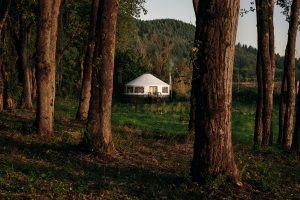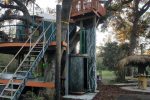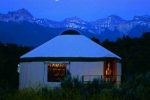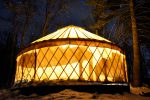Permits and Legality
Main specs for American yurt companies (organized alphabetically). Updated December 2019. Pacific Yurts declined to provide information for this website.
Yurt Company Acronym Key
- BR = Blue Ridge Yurts
- CY = Colorado Yurt
- GL = Great Lakes Yurt Co
- LI = Living Intent Yurt Co
- NS = Nomad Shelter
- RO = Rainier Outdoor
- SD = Shelter Designs
- YA = Yurts of America
Company Contact
| Company | Website | Phone Number | |
|---|---|---|---|
| BRBlue Ridge Yurts | blueridgeyurts.com | [email protected] | (540) 745-7458 |
| CYColorado Yurt | coloradoyurt.com | [email protected] | (800) 288-3190 |
| GLGreat Lakes Yurt Co | greatlakesyurtco.com | [email protected] | (269) 808-3664 |
| LILiving Intent Yurt Co | livingintentyurts.com | [email protected] | (207) 350-9457 |
| NSNomad Shelter | nomadshelter.com | [email protected] | (907) 235-0132 |
| RORainier Outdoor | rainieroutdoor.com | [email protected] | (866) 483-6795 |
| SDShelter Designs | shelterdesigns.net | [email protected] | (406) 721-9878 |
| YAYurts of America | yurtsofamerica.com | [email protected] | (317) 377-9878 |
Company Details
| Company | Location | Year First Yurt Sold | Tour Available? |
|---|---|---|---|
| BRBlue Ridge Yurts | Floyd, VA | 2004 | |
| CYColorado Yurt | Montrose, CO | 1980 | |
| GLGreat Lakes Yurt Co | Grass Lake, MI | 2017 | — |
| LILiving Intent Yurt Co | Grass Valley, CA | 2015 | |
| NSNomad Shelter | Homer, AK | 1987 | |
| RORainier Outdoor | Tukwila, WA | 2004 | |
| SDShelter Designs | Missoula, MT | 2005 | |
| YAYurts of America | Indianapolis, IN | 1986 | — |
Yurt Info
| Company | Available Sizes | Max Snow Load* | Base Cost of 30' | Base Cost of 16' |
|---|---|---|---|---|
| BRBlue Ridge Yurts | 16', 20', 24', 30' | 60 psf | 60 psf | $13,047 | $7,299 |
| CYColorado Yurt | 16', 20', 24', 27', 30' | 15 psf | 95 psf† | $12,240 | $7,090 |
| GLGreat Lakes Yurt Co | 16', 20', 24', 27', 30' | 75 psf | 75 psf | $11,000 | $5,000 |
| LILiving Intent Yurt Co | 12', 14', 16', 20' | — | — | $6,000 |
| NSNomad Shelter | 12', 16', 20', 24', 30', 34', 40', 50' | 60 psf | 60 psf | $15,500 | $8,000 |
| RORainier Outdoor | 16', 18', 21', 24', 27', 30', 33' | 100 psf | 105 psf† | Eagle: $18,820, Raven: $13,358 | Eagle: $9,466, Raven $7,426 |
| SDShelter Designs | 12', 16', 20', 24', 27', 30', 35', 40' | 40 psf | 150 psf | $12,480 | $6,760 |
| YAYurts of America | 12', 14', 16', 20', 30' | 60 psf | 95 psf | $12,000 | $6,499 |
*(30' yurt without upgrades | 30' yurt with all upgrades), †Site specific engineering available for higher snow loads
Rafter Details
| Company | Wood Species | Base Rafter Size for 30' |
|---|---|---|
| BRBlue Ridge Yurts | Spruce | 2x6 |
| CYColorado Yurt | Doug Fir | 2x4 |
| GLGreat Lakes Yurt Co | Doug Fir | 2x6 |
| LILiving Intent Yurt Co | Doug Fir | — |
| NSNomad Shelter | Spruce | 2x6 |
| RORainier Outdoor | Doug Fir | 2x6 |
| SDShelter Designs | Western Tamarack (Larch) | 2x6 |
| YAYurts of America | Southern Yellow Pine | 2x6 |
Lattice Details
| Company | Wood Species | Lattice Thickness | Base Height of Wall |
|---|---|---|---|
| BRBlue Ridge Yurts | Poplar | 3/4" | 7' 4" |
| CYColorado Yurt | Doug Fir | 1/2" | 7' 2" |
| GLGreat Lakes Yurt Co | Doug Fir | 1/2" | 7' 4" |
| LILiving Intent Yurt Co | Bamboo | 1/2" | 6' 9" |
| NSNomad Shelter | Spruce | 7/8" | 7' |
| RORainier Outdoor | Doug Fir | 3/4" | 7' 4" |
| SDShelter Designs | Doug Fir | 7/16" | 7' 2" |
| YAYurts of America | Poplar | 3/4" | 7' |
Available Upgrades
| Company | Insulation |
Thick Roof Cover |
French Doors |
SIP Panels |
Glass Windows |
Awnings |
Rain Diverter |
Opening Dome |
Tinted Dome |
Water Catchment |
Wind & Snow Package |
10ft Walls |
Swappable Walls |
|---|---|---|---|---|---|---|---|---|---|---|---|---|---|
| BRBlue Ridge Yurts | — | — | — | ||||||||||
| CYColorado Yurt | — | — | — | ||||||||||
| GLGreat Lakes Yurt Co | — | — | — | — | — | — | — | — | — | — | |||
| LILiving Intent Yurt Co | — | — | — | — | — | — | — | — | |||||
| NSNomad Shelter | — | — | — | — | — | — | — | — | — | — | — | ||
| RORainier Outdoor | — | ||||||||||||
| SDShelter Designs | — | — | |||||||||||
| YAYurts of America | — | — |
Final Details
| Company | Lead Time | Shipping Available | Financing Available | On-site Construction Services | International Purchasing |
|---|---|---|---|---|---|
| BRBlue Ridge Yurts | 3-4 weeks | — | — | ||
| CYColorado Yurt | 5-8 weeks | ||||
| GLGreat Lakes Yurt Co | 6-8 weeks | — | — | ||
| LILiving Intent Yurt Co | 7 weeks | — | |||
| NSNomad Shelter | 6-12 weeks | ||||
| RORainier Outdoor | 3-7 weeks | ||||
| SDShelter Designs | 4-6 weeks | — | |||
| YAYurts of America | 2-5 weeks |
Codes and Regulations
Without a doubt, the most common question from anyone interested in building their own yurt is about legality—and for good reason! It’s a complex and time-intensive part of the process. The tricky thing is that there is no one-size-fits-all answer to this question of yurt building permits. Every single state and every single county in the US will have their own rules about how a yurt can be permitted and how it cannot. Some counties may enthusiastically allow you to build a yurt without a permit or inspections and some may only want you to seek a permit for the platform deck. Other counties may be so inflexible that they will not permit a yurt as a permanent structure or place of residence—end of story. Even the brand of yurt you are planning to build will be the difference between getting the green light or not. Every place is wildly different when it comes to yurts.
The Grey Area
The legality (or lack thereof) is the dirty little secret of the yurt industry. The unfortunate truth is that most yurt companies will not tell potential customers just how difficult it is to build a yurt through the normal legal process. The bigger and more populated the county, the more difficult it tends to be to get a building permit. Because of this, many yurts built—especially those in the rural countryside, away from neighbors and far from the oversight of strict counties—are done so without permits. The risk is that your structure may get reported and forced to be taken down by the county if they find you built it without their stamp of approval.
Permit Process
If you’re going by the book, the best advice is to speak with your local building officials about what it takes to make your yurt comply with their code. They will be able to provide information for the minimum required snow load, seismic rating, wind speed and fire safety in your area. Many building officials will have little to no experience with yurts so you may need to educate them. Don’t be afraid to bring in various materials for them to review. Show them your yurt company’s promotional material, bring in a book about yurts or show them this very website. If they can better visualize exactly what you are trying to build, the more likely they won’t misunderstand or mischaracterize your future home. In many cases, your yurt company will be willing to work with you to provide more detailed information like engineering specs that can be used by a local certified engineer.
Yurt Insulation and Energy Code
Much of the permitting discrepancies with officials will be about yurt heating and energy code. A majority of yurts rely on reflective insulation instead of normal, conductive insulation. Reflective insulation will reflect heat back into the space while your heat source is operating and is more efficient at doing so that conductive insulation. Reflective insulation does not contain the heated air once the heat source is turned off. There are currently no guidelines in building codes about reflective insulation and instead, codes rely on R-value alone—which reflective insulation scores very low on.
You may add conductive style insulation to your yurt with additional framing, however, that will also require you to cover up all of the lattice walls and roof, which would make your yurt a very permanent structure. At that point, you may be better off building a traditional round home that is more akin to a standard house.
Your last option is to appeal for exemption to the code if you are incorporating a renewable heat source. You may be rewarded an exemption by using a wood stove fueled by dead or thinned trees or electric heaters run on solar, wind or hydropower. You may also receive an exemption if your yurt is only be used seasonally or intermittently as a rental property.
Temporary vs Permanent
Unlike the nomadic yurts of the past, modern yurts are built on permanent or semi-permanent foundations which automatically groups the yurt into a much more stringent classification in the eyes of local building officials and counties. Most codes classify a temporary structure as something that is only erected for a maximum of six months. While a small yurt kit may be something you would have up for a summer, larger yurts that take weeks to construct are not structures you will want to deconstruct after six months.
Can it be something?
Yurts built with the intention of living in them full-time will come under more requirements regarding egress, occupancy, sewage and so on. Likewise, yurts used for commercial purposes will also have their own rules that need to be followed. The scenario that will provide you the least amount of headache and the most amount of flexibility will be a yurt used as an auxiliary structure. This could be a personal workshop, yoga room, art studio—the list goes on. If you tell your building official that the purpose of your yurt falls within a similar use they may be much more flexible… And if you take the occasional overnight nap inside, I won’t tell 😉
Previous Chapter

Safety and Security
Next Chapter




